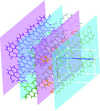issue contents
May 2015 issue

Cover illustration: A centrosymmetric TeII complex supported by ditelluridoimidodiphosphinate ligands has been structurally characterized. This compound is the first all-tellurium member of a series of related square-planar EII(E')4 complexes (E and E' are group 16 elements). See Chivers & Ritch [Acta Cryst. (2015), C71, 407-409].
research papers
Download citation


Download citation


In the title compound, each of the R- and S-isomers are stacked into columns by C—H⋯O=C hydrogen bonds between the benzene rings and the carbonyl groups. The columns of one enantiomer are connected with the counterpart isomeric columns by C—H⋯F hydrogen bonds between the methoxy groups and the F atom of the aroyl groups to yield a stripe structure.
CCDC reference: 1055291
Download citation


Download citation


Three symmetrically independent complex molecules have a similar conformation, with two chelating Me2tn (2,2-dimethylpropane-1,3-diamine) ligands in an anti conformation coordinating a CrIII centre in the equatorial plane, and two Br atoms in the axial positions of a distorted octahedron. The packing is stabilized by hydrogen bonds between the amino groups of the Me2tn ligands as donors and the Br ligands and perchlorate counter-ion O atoms as acceptors.
CCDC reference: 1055916
Download citation


Download citation


4,4′-Bipyridine-1,1′-diium acetylenedicarboxylate, a one-dimensional structure with alternating cations and anions, is a new member of the (H2bipy)[Cu(ox)2] family reported earlier. The supramolecular isostructurality is ascribed to the synergistic effect of multiple interactions in the structures, including strong charge-assisted N—H⋯O hydrogen bonds, C—H⋯O contacts and π–π interactions.
CCDC reference: 1056679
Download citation


Download citation


1-Aryl-5-chloro-3-methyl-1H-pyrazole-4-carbaldehydes react with cyclohexylamine by nucleophilic substitution when the aryl substituent is pyridin-2-yl to give 5-cyclohexylamino-3-methyl-1-(pyridin-2-yl)-1H-pyrazole-4-carbaldehyde, and by condensation followed by hydrolysis when the aryl substituent is phenyl to give (Z)-4-[(cyclohexylamino)methylidene]-3-methyl-1-phenyl-1H-pyrazol-5(4H)-one.
Download citation


Download citation


A novel two-dimensional cadmium(II) coordination polymer is composed of one-dimensional [Cd3(e,e-trans-1,4-chdc)2(4-PyBIm)2(H2O)2]n chains [4-PyBIm is 2-(pyridin-4-yl)-1H-benzimidazole and 1,4-chdc2− is cyclohexane-1,4-dicarboxylate] joined by e,a-cis-1,4-chdc2− ligands.
CCDC reference: 1055478
Download citation


Download citation


Dihydrogen phosphate anions show a supramolecular flexibility depending on the nature of the cations and may be suitable for the design of the host lattice for host–guest supramolecular systems. In the salt 1-methylpiperazine-1,4-diium bis(dihydrogen phosphate) and the solvated salt 2-(pyridin-2-yl)pyridinium dihydrogen phosphate–orthophosphoric acid (1/1), the formation of O—H⋯O and N—H⋯O hydrogen bonds between the dihydrogen phosphate anions and the cations constructs a three- and two-dimensional anionic–cationic network, respectively.
Download citation


Download citation


The phenyloxalamate group has become a particularly important and versatile supramolecular building block in the context of conformationally controlled molecular clefts.
CCDC reference: 1057703
Download citation


Download citation


The structure of (2-aminopyrimidine-κN1)aqua(pyridine-2,6-dicarboxylato-κ3O2,N,O6)copper(II) is compared with three similar previously reported compounds. Close Cu⋯Xbridged (X = N or O) contacts are present between potentially ligating atoms from neighbouring molecules and the CuII centre. Bond-order indices have been employed to elucidate the degree of covalency in these interactions and its implications for the effective coordination number of the transition metal atom.
CCDC reference: 1054348
Download citation


Download citation


Crystal structures are reported for a new polymorph of the drug niclosamide, together with acetone and acetonitrile solvates and the monohydrate polymorph HA.
Download citation


Download citation


Molecules of a substituted β-D-uridine are assembled by N—H⋯O and O—H⋯O hydrogen bonds into well-separated two-dimensional layers of about 15 Å thickness. The crescent conformation of the molecules is stabilized by weak intramolecular C—H⋯O and C—H⋯F hydrogen bonds. The endocyclic uracil bond lengths imply a considerable degree of delocalization of the electron density within the ribofuranose ring.
CCDC reference: 1057607
Download citation


Download citation


A centrosymmetric TeII complex supported by ditelluridoimidodiphosphinate ligands has been structurally characterized. This compound is the first all-tellurium member of a series of related square-planar EII(E′)4 complexes (E and E′ are group 16 elements).
CCDC reference: 1060938
Download citation


Download citation


All known 4-(2,4,6-triisopropylbenzoyl)benzoate salts are photochemically active in the crystalline state. The lack of photochemical reactivity for the sodium salt is explained on the basis of intermolecular interactions and the molecular geometry in the crystals.
CCDC reference: 1061577
Download citation


Download citation


The new potential NLO (nonlinear optical) material L-argininium phosphite was obtained from a 1:1 solution of L-arginine and phosphorous acid. The composition of the product obtained from the 1:2 solution is proposed on the basis of spectroscopic data.
addenda and errata
Open  access
access
 access
access

 journal menu
journal menu































